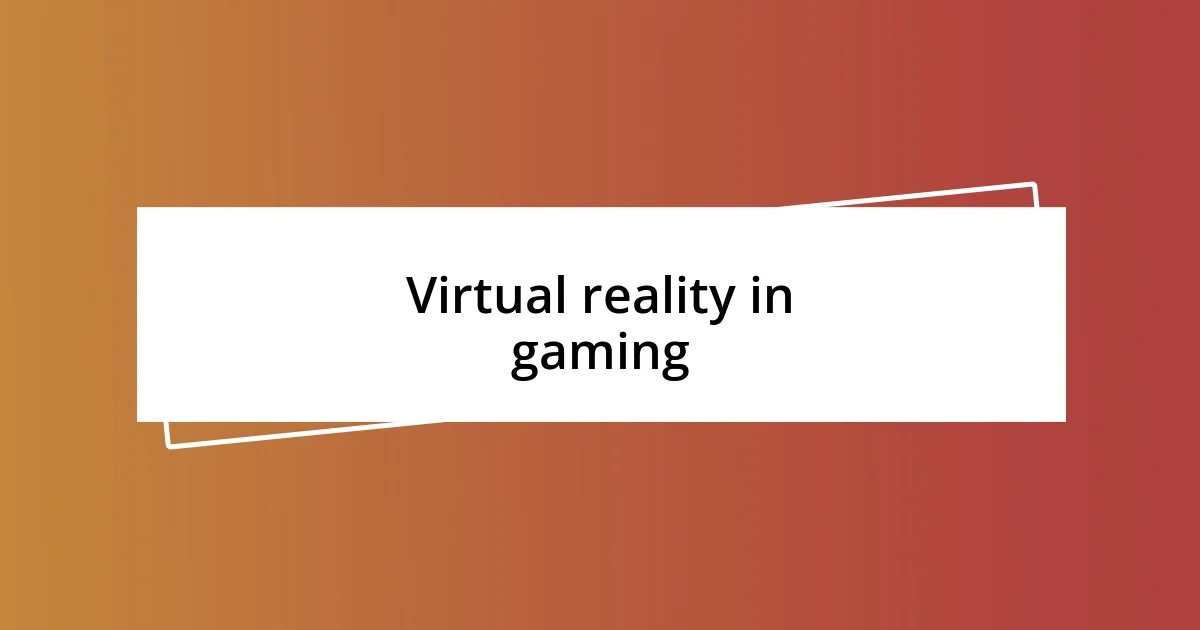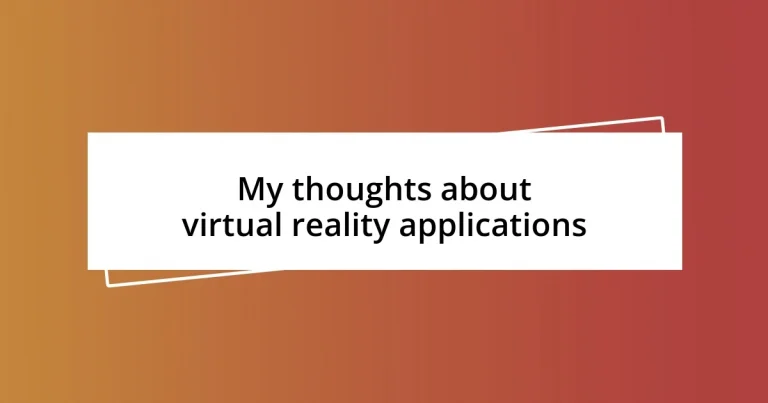Key takeaways:
- Virtual reality (VR) enhances immersive experiences across various fields, including education, therapy, and gaming, offering unique and engaging learning opportunities.
- VR technology significantly aids mental health therapy by providing controlled environments for exposure therapy, allowing users to confront fears safely.
- Challenges in VR adoption include high costs, potential motion sickness, and a learning curve that can hinder user experience and accessibility.

Understanding virtual reality applications
Virtual reality (VR) applications are essentially immersive experiences that transport users into digital environments, making them feel as if they are truly present within a different space. I remember the first time I slipped on a VR headset; the sensation was exhilarating. It genuinely felt like I had stepped into an art gallery where I could walk around, examining masterpieces up close—how often do we get such a unique perspective in the physical world?
One of the most intriguing aspects of VR applications is their versatility. From gaming and education to therapy and training, the possibilities are nearly endless. I often wonder, what if we could use this technology to simulate real-life scenarios for skills training? Imagine a medical student virtually performing surgery before stepping into an operating room. The idea is not just fascinating; it’s a game-changer in how we learn and practice essential skills.
What moves me most about VR is its ability to evoke emotions and create connections. I’ve experienced moments in VR that made me feel a profound sense of empathy. For instance, participating in a simulation that put me in someone else’s shoes—adopting a different perspective on a social issue—left a lasting impact on how I view reality. Can technology really reshape our understanding of the world? I believe it has the potential to do just that, one immersive experience at a time.

Benefits of virtual reality technology
Virtual reality technology brings numerous benefits that can significantly enhance various aspects of our lives. For instance, in education, I’ve seen students engage more deeply with subjects when they can visualize complex concepts through VR. This interactive learning method doesn’t just keep them interested; it allows for retention that’s often more effective than traditional methods. When learners can explore a historical site or conduct a chemistry experiment in a virtual lab, their understanding deepens in ways I find truly inspiring.
Moreover, VR has found promising applications in mental health therapy. I recall reading about a case where virtual reality was used to help individuals cope with anxiety disorders. Clients could confront their fears slowly and safely in a controlled environment. This approach has proven transformative—participants often report a significant reduction in anxiety levels. Isn’t it incredible how technology can empower us to overcome challenges that once felt insurmountable?
The potential for teamwork and collaboration in virtual spaces is another significant advantage. I’ve had the opportunity to join virtual meetings where distance became irrelevant. Collaborating with colleagues around the globe created a unique environment—one where ideas flowed freely, and cultural barriers seemed to fade. The shared virtual space made discussions more dynamic and engaging, driving creativity and innovation. What could possibly be better than feeling connected to people, no matter where they are?
| Benefit | Description |
|---|---|
| Enhanced Learning | Immersive VR experiences boost engagement and retention in education. |
| Mental Health Support | VR offers safe environments for confronting fears, significantly aiding therapy. |
| Global Collaboration | Virtual spaces break distance barriers, fostering creativity and dynamic teamwork. |

Popular virtual reality uses
I appreciate how diverse the applications of virtual reality are, with new uses emerging constantly. One area that truly fascinates me is gaming; the immersive experiences offered in this realm have completely transformed how we interact with digital entertainment. I recall a gaming session where I found myself navigating a fantastical world, fighting dragons and solving puzzles as if I were the hero of the story. It’s astounding how VR can turn a simple pastime into an exhilarating adventure that feels more like living a story than just playing a game.
In addition to gaming, virtual reality has made significant strides in fields like training and simulation. Professionals can now practice high-pressure situations without the real-world consequences. I was amazed when I attended a VR workshop for emergency responders. They engaged in life-like scenarios where they had to make decisions under stress—simulating everything from a fire rescue to providing first aid. Witnessing their focused determination in that environment showcased how VR might be the key to enhancing preparedness and confidence in crucial roles.
Here are some popular uses of virtual reality:
- Gaming: Immersive environments allow players to feel genuinely part of the game world, enhancing emotional engagement.
- Education: Virtual classrooms and interactive experiences bring subjects to life, making learning both fun and meaningful.
- Training and Simulation: Professionals in fields like healthcare and emergency services can practice real-world skills safely and effectively.
- Therapy: VR is being used to treat anxiety disorders by providing controlled settings for exposure therapy.
- Social Interaction: Platforms allow users to meet and interact with others in virtual spaces, fostering connections across distance.

Virtual reality in education
I’ve noticed that the integration of virtual reality in education opens up a world of possibilities. Just the other day, a friend of mine shared how her daughter was able to “walk” through the ancient ruins of Rome in a VR classroom. Can you imagine experiencing that firsthand? It’s one thing to read about history in a textbook, but immersing yourself in it really ignites a passion for learning that I believe is hard to replicate through traditional methods.
What really excites me is the potential for experiential learning through VR, especially in subjects like science. I once participated in a virtual biology lab, where we simulated a dissection. I was initially apprehensive, but the experience turned out to be so engaging and enlightening. It allowed me to grasp complex concepts in a way that felt much more tangible. This hands-on approach fosters curiosity and understanding, which I think is essential for education today.
Furthermore, the collaborative aspect of virtual reality in education truly stands out to me. Imagine students from different backgrounds coming together in a virtual space, working on a project as if they were in the same room. In a recent online seminar, I experienced this firsthand as we brainstormed ideas with peers from across the globe. It was eye-opening to hear diverse perspectives, proving that education isn’t just about acquiring knowledge—it’s also about connecting with others and learning from their experiences. Don’t you find it amazing how technology can break down barriers and enhance our learning journeys?

Virtual reality in gaming
Virtual reality in gaming is truly a game changer—quite literally! I remember the first time I slipped on a VR headset; it felt like my living room transformed into an expansive battlefield. The sensation of ducking behind cover and physically reaching out to grab virtual weapons was electrifying. I found myself completely immersed, as if my body and mind were part of the game.
What really strikes me is the emotional depth VR can bring to gaming. I recently played a narrative-driven adventure that tugged at my heartstrings. The choices I made felt monumental since I was not just a passive observer; I was living through the character’s joys and sorrows. Have you ever felt that intense connection to a game? It’s almost as if the line between reality and fiction blurs, and that emotional engagement keeps me coming back for more.
There’s also a social aspect to VR gaming that fascinates me. I joined friends in a virtual escape room, working together to solve puzzles and unravel mysteries as if we were all in the same physical space. The laughter and adrenaline we shared made me realize how VR can bridge distance and enhance friendships, turning gaming into a collective experience that feels more like a bonding adventure than just a solo activity. Isn’t it remarkable how technology can amplify our social interactions in such creative ways?

Challenges of virtual reality adoption
Adopting virtual reality isn’t without its hurdles. One main challenge is the cost associated with the high-quality hardware. When I first looked into purchasing a VR headset, I was shocked at the price tag. It made me question whether the benefits justified the investment. For many, this upfront cost can act as a significant barrier, especially for educational institutions that are already working within tight budgets.
Another issue I often hear about is the potential for motion sickness. I experienced this firsthand when I tried a VR flight simulator. While the visuals were breathtaking, I found myself feeling nauseous after just a few minutes of flying. It’s a common reaction for many users, and it raises concerns, especially for VR applications in settings like schools or training environments. How can we expect people to fully engage if they’re struggling with discomfort?
Then there’s the learning curve associated with VR technology. I remember when I introduced a friend to VR gaming; it took her a while to get accustomed to the controls and the whole immersive experience. It made me realize that for some, the initial excitement may quickly turn into frustration rather than a passion. How can we better support new users to bridge that gap and ensure a smooth transition into the world of virtual reality? This ongoing challenge is essential to address if we truly want to broaden VR’s appeal.














